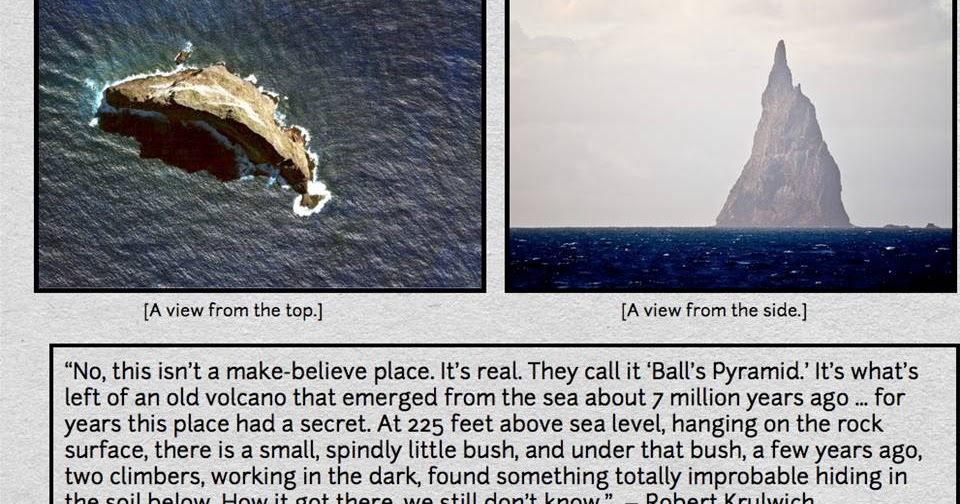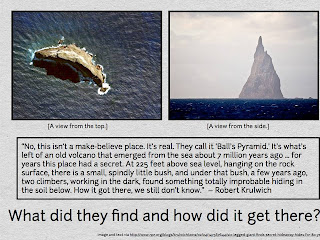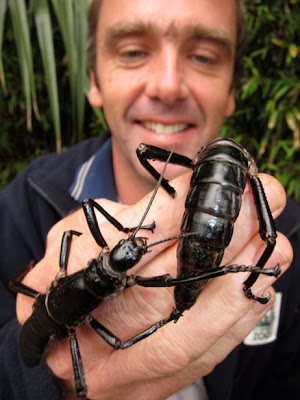August
Metanoia

The Mystery of Ball's Pyramid: Revealed

Welcome back to Ball's Pyramid. Last week I shared this writing prompt with you and promised you that I'd reveal the rest of the story soon. So, let's see what the rest of the story tells us.
Ball's Pyramid is part of a very small archipelago (several underwater sea mounts and a few neighboring islands) off the coast of Australia. It was named after Lieutenant Henry Lidgbird Ball, who discovered it in 1788. Nearby is a bigger, perhaps more well known island called Lord Howe Island.
Ball's Pyramid is part of the submerged continent of Zealandia. That's right - continent. Did you know we have more than the standard 7 continents that currently adorn the map? I love to learn about the geologic history of our planet, and learn about how the continents formed, moved into and out of each other, sunk, and rose above sea level. Amazingly enough, our planet has looked very different through the course of history. Most school children learn about Pangea, the supercontinent. Actually, that's just the most recent continental configuration prior to our current continental placements. About 250 million years ago Pangea began breaking apart and plate tectonics has shifted the current continents we know and love into the places we are familiar with today. However, at times there has been much more or much less continental land above water. At one time there was a supercontinent (Pannotia) where all the land was placed over the South Pole - and it caused a global ice age that even froze waters in the oceans for millions of years. Pretty cool, huh?
But, back to Zealandia. Zealandia was the area of land between Australia and Antarctica. About 250 million years ago the supercontinent Pangea broke into 2 smaller continents. The southern continent was Gondwana, which included Africa, Antarctica, Australia, and India. Australia broke away from Antarctica about 100 million years ago. Then, part of Australia broke away from the mainland (Zealandia) about 70 million years ago. Shortly after breaking away from Australia, Zealandia sunk. Prior to sinking, Zealandia was a flourishing ecosystem of pine forests and animal life. This animal life, after millions of years of pressure, provides a large gas field just offshore of New Zealand.
Now that you have some history of the area, onto the answer of the mystery (which has nothing to do with geology or ancient continents, but they are just so interesting!).
It turns out that this entire mystery is about bugs. Living bugs. But, ancient bugs. They've been around since ancient times, at least 22 million years ago. These huge stick bugs, sometimes called tree lobsters, were once very common on Lord Howe Island (remember, the bigger island near to Ball's Pyramid).

These huge stick insects were endemic to Lord Howe Island. That means, it was the only place that they were found. These are giant insects - 12 centimeters long and one of the largest flightless insects in the world. Fisherman regularly used these bugs as bait. Back in the early 1900's a ship ran aground at Lord Howe Island. During the few days it took to repair the ship, black rats from the ship somehow made their way to shore with some of the goods. And, the rest is history. Like many a tale involving an exotic species introduced to a new habitat, the black rats thrived at the expense of the natives. Giant stick bugs were a delicacy to the rats, and within a short time they had wiped them off the island. By 1920 there were no more sightings and by 1960 giant stick insects were officially labeled as extinct. To read more details in a fun narrative style, visit this website: Six-Legged Giant Finds Secret Hideaway, Hides For 80 Years
So - the tie-in to Ball's Pyramid? Take a guess.
There's not much to Ball's Pyramid. Not much soil, not many plants, and not much animal life. Human's mostly visit to climb the steep mountain. Rumors from past climbers indicated they had seen rather large stick insects (recently dead). Expeditions visited Ball's Pyramid to look for the giant stick insects, but between the nocturnal behavior of the insects and the sheer cliff faces, they didn't have much luck. Until 2001. An group of scientists came to the island specifically looking for the giant stick insects. They used special equipment to climb at night, with spotlights, and finally found living specimens under one of the few bushes on the island. All told, they found 24 insects living at this one shrub. This was assumed to be the only living population of giant stick insects currently alive.
The next part of the story involves politics of endangered species conservation. To make a long story short, there was approval to take only 4 insects away from the island (a couple of years after the discovery) in order to try to breed them to increase the population. The 4 insects were split into 2 pairs and separated to different scientific organizations. One pair quickly died. The second did not, although there were some tough times. But, overall, it was successful, and they have managed to raise a lot of babies. More currently, there is talk of trying to remove the rats from Lord Howe Island and reintroduce the giant stick bug back to its native habitat.
But - back to the mystery of Ball's Pyramid. Think about this. Here were 24 insects, from a species presumed extinct over 50 years before. The were also from an island that is quite a distance away for even a big bug like this. Giant stick insects do not fly. And they do not swim. Could they have managed to migrate to a totally different island? If so, how? And could these insects be actual descendants of the Lord Howe giant stick bugs? Ball's Pyramid is a very desolate place, so it would never be able to support very many insects. Could such a small population size (centered around just one bush) be able to sustain itself for 50-100+ years? These are the real mysteries.
In answer to one question - it does seem like these are the same species as the Lord Howe giant stick bugs. This scientific study compared the DNA of several insects in the same Order as the giant stick insects (Kingdom Phylum Class Order Family Genus Species). To read more on how they determined this, visit: http://rspb.royalsocietypublishing.org/content/276/1659/1055.full
But, as to the rest, who knows? Perhaps birds managed to bring over insect eggs or larva in some way from Lord Howe Island to Ball's Pyramid. Maybe there was a tropical storm that washed vegetation far enough to reach the other island. Maybe floating mats of vegetation served as temporary migratory homes. Apparently the giant stick bugs did manage to make the trip from Lord Howe Island to Ball's Pyramid. As for how they stayed alive? Probably a bit of luck, lack of predators, and adaptability. Perhaps now that they've been reborn as a Lazarus species and come back under human consideration they will be helped to thrive.
What are your thoughts? Should humans help animal species facing extinction? Does your opinion change if humans were the cause the endangerment?
